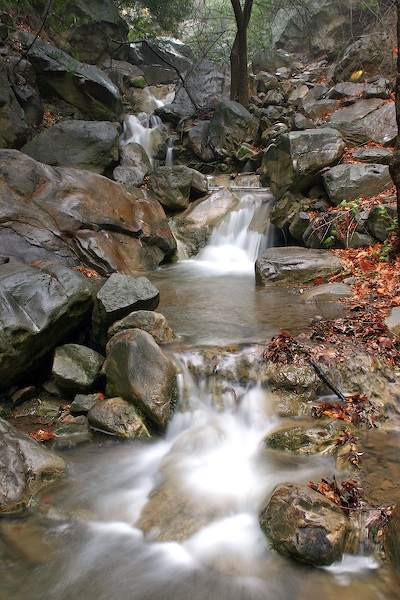
TRAIL INFORMATION
Distance-.4 miles to Romero power line trail; .5 to canyon trail; 2 miles to intersection with upper road; 4 miles to crest via the upper trail or 3.5 miles to Romero Saddle via the upper road
Elevation Gain-1500′ to intersection with Romero Road; 2175′ to the top of the trail; or 2000′ to Romero Saddle
Difficulty– Moderate to strenuous
Topo– Carpinteria (the trail isn’t on the map)
View Photo Gallery
HIGHLIGHTS
Romero Trail is one of the few front country trails which actually constitutes a loop. This is because the canyon trail starts at the bottom of Romero Road, now abandoned, and then intersects it again about two-thirds of the way to the crest. Though the creek is small the canyon is very picturesque. Because it is a bit out of the way, the trail doesn’t enjoy the popularity of those directly behind Santa Barbara, meaning you will often have it all to yourself. The upper end of the trail leads to the summit at one of the highest elevations of any of the crest trails, thus providing wonderful views.
DIRECTIONS
From Highway 101 take the Sheffield Drive exit. Follow it 1.5 miles to East Valley Road. Turn left, then almost immediately to the right on Romero Canyon Road and continue another 1.5 miles to Buena Vista and turn right on it. The trailhead is about .3 miles. You will find a locked red steel gate marking the trail’s beginning.
THE HIKE
Once you pass the locked gate you will find yourself walking up remnants of the old Romero Road. The canyon is relatively narrow and the oak trees lining the creek side of the road make this part of the walk very nice. The road levels out a bit at the point where you cross an old concrete bridge and just beyond this it splits. The left fork goes steeply up to the powerlines, then across the upper foothills on a mile of relatively level hiking. Eventually, this road will take you to San Ysidro Canyon.
Follow the right fork across the creek and then up a very pretty section of the old road to a second crossing a few hundred yards further on. Just as you cross the creek look for a sign on the left marking the start of the canyon trail.
The canyon is very quiet and secluded, with plenty of nice spots to stop and rest, though no pools to dip in. For the first half mile the trail stays on the right side of the creek, following a small ridge steadily uphill through a series of oak forests. Then, the trail crosses to the left side of the creek and continues along the creek another quarter mile to a crossing where there is a small but very pretty moss and fern-lined waterfall and pool. This is a wonderful spot to stop for lunch.
From here it is about a half mile to the end of the canyon section. The trail leads up along the right side of the creek through a sweet-smelling forest of California bay trees then crosses the creek at a point where it branches into two forks. The trail follows the west branch of Romero Creek, then switches back and forth several times until it reaches Romero Road.
From here most people will turn right and return back down on the old road. It is a longer trip back if you take the road-3.5 miles versus 1.5 miles via the canyon route-but the views are great and it is easy walking.
The upper part of the Romero Trail is just across the road. From the look of the steep uphill on the other side of the road, the upper trail looks like it will be tough hiking and take you straight up to the crest. However, this is not the case. After the first hundred yards the uphill levels out and for the balance of the hike is relatively mellow hiking.
There are several switchbacks leading up to the left through fairly thick chaparral and then the trail turns back to the east and begins to climb gradually around the headwalls of the upper canyon. After you round the first of a series of ins and outs, the taller chaparral gives way to yerba santa, white sage and other plants which are rarely more than waist high and the views down the canyon are great.
Ahead, you can spy a series of switchbacks which will take you up the final hill . They appear intimidating, but once you reach them you will find the hiking to be no more difficult than the previous half mile. Above the switchbacks, the hillsides turn to grass and if you turn around you will find yourself looking back down on some of the best views of the coast.
The high point on the Romero crest is in a small saddle. The Romero Trail continues north, dropping down a thin canyon. Eventually it will take you to Blue Canyon and if you go far enough, the Santa Ynez River. Though no longer maintained and somewhat scarred by past use by motorcyclists, the Island View-leads either to the left or right along the crest.
A left turn will take you to Romero Saddle-which you will have already spotted on the hike up the last section of trail-though you will have to climb one last big hill to get there. It isn’t too difficult and what you will be rewarded with from the top of the peak are views of the entire back country, stretching from Old Man Mountain and Divide Peak on the east horizon to the San Rafael range on the middle and western horizon.
From Romero Saddle you can take the road back down. The trail begins just on the west side of the cement water tank. It is 1.5 miles down to the intersection with the canyon trail you came up.



